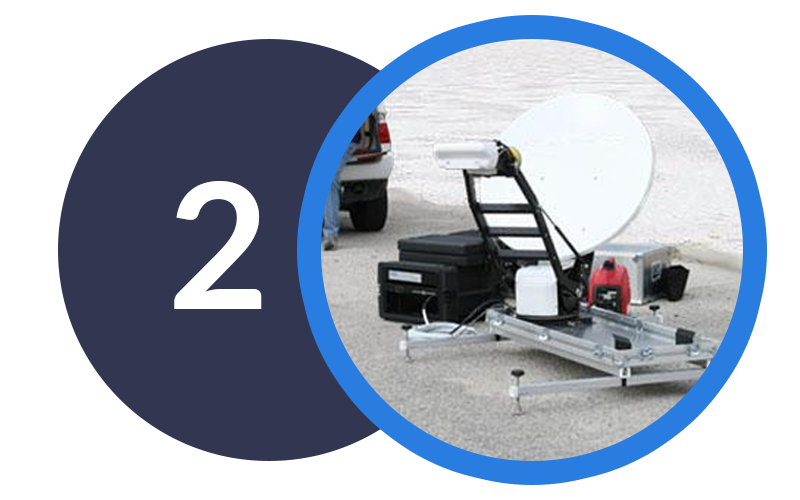Satellite communications have revolutionized the way police forces operate. Not only has satellite communication technology transformed the reach, reliability and robustness of global connectivity, but it has also provided law enforcement agencies with a powerful tool to enhance their capabilities and improve citizen safety.
In this blog post, we will explore the crucial role and key benefits of satellite-based communication in modern policing and law enforcement practices.
5 benefits of satellite communication for modern policing
1. Seamless connectivity
Satellite communications have the unrivaled ability to establish connectivity even in the world’s most remote and underserved areas. Traditional terrestrial communication networks are often unable to provide reliable coverage in rural regions, national parks, or disaster-stricken areas.
Unlike traditional terrestrial communication systems that often suffer from limitations such as range restrictions, network congestion, and vulnerability to natural disasters or deliberate disruptions, satellite provides a reliable and resilient communication infrastructure that can overcome these challenges. This capability enables law enforcement personnel to remain connected, allowing them to communicate and access critical information, regardless of location.
2. Rapid deployment and flexibility
Satellite communication systems offer rapid deployment capabilities, making them ideal for law enforcement operations that require immediate connectivity. Whether it’s establishing a temporary policing command post, setting up communication networks in disaster-stricken areas, or deploying resources to remote locations, satellite solutions can provide the required flexibility.
A mobile VSAT system could be mounted on the ground, on top of a vehicle, truck, trailer, or even transported in the back of an SUV. Deployment is rapid and suitable for any location – providing a robust, high-speed internet and communications solution. Police forces can subsequently reliably achieve quick, uninterrupted connectivity and operational effectiveness in dynamic and evolving situations.
3. Improved inter-agency collaboration
US law enforcement agencies need to collaborate with multiple agencies during joint policing operations, cross-border investigations, and when combining interagency task forces. Satellite communications enable the facilitation of seamless, secure communication and data sharing between these different agencies, regardless of their geographical location.
In rural areas, satellite-based connectivity can be the only way to achieve this as traditional communication systems like cellular and LMR are typically, much more limited. Satellite enabled messaging devices support rural-based police officers by providing reliable tracking and messaging anywhere in the world, powering collaboration across multiple regions, enhancing policing coordination, and strengthening the overall effectiveness of law enforcement efforts.
4. Real-time surveillance and intelligence gathering
Real-time surveillance monitors high-risk areas, tracks suspects, and shares data with other police forces and agencies for more coordinated operations and successful crime combating. Satellites equipped with high-resolution imaging sensors can provide real-time or near-real-time imagery of vast areas, enabling law enforcement agencies to monitor critical locations, track multiple suspects, or identify potential threats to life. This advanced surveillance capability helps to serve better public safety in the US and the world.
5. Coordinated disaster management and emergency response
During natural disasters, satellite communications play a crucial role in maintaining communication lines when terrestrial infrastructure is damaged, overloaded, or otherwise fails. When this happens, satellite serves as a lifeline for law enforcement agencies to coordinate response efforts, share critical information, and request additional resources. Furthermore, satellite connectivity enables mobile command centers to be established quickly so police can set up communication hubs out in the field during emergency and critical situations. This enables efficient coordination, resource allocation, and decision-making in real time. In the wake of the Boston Marathon bombings, police and the FBI relied on satellites as cellphones were unreliable in the bombing aftermath.
Closing thoughts…
Satellite communication technology offers numerous benefits to law enforcement agencies. From seamless connectivity in remote areas to enhanced surveillance capabilities, satellite technology has become an invaluable tool for improving operational efficiency and public safety. The ability to establish reliable communication during emergencies, support inter-agency collaboration, and provide global reach strengthens the overall effectiveness of law enforcement efforts all over the world.
By harnessing the power of satellite communications, law enforcement and policing agencies can adapt to the ever-evolving landscape of modern crime and ensure safer and more secure communities. As satellite grows in popularity, so too do the service options, and the competitiveness of the pricing. It’s anticipated that in the next few years, satellite and cellular networks will effectively merge, which will open up more possibilities to support policing and law enforcers.
Harness the Power of Satellite Communications
Contact us today. We'll be able to help and offer impartial advice on the best solutions to improve your operational and connectivity challenges.






